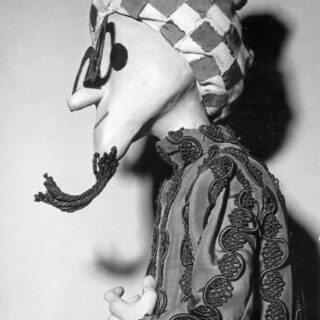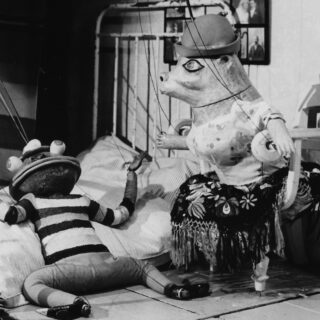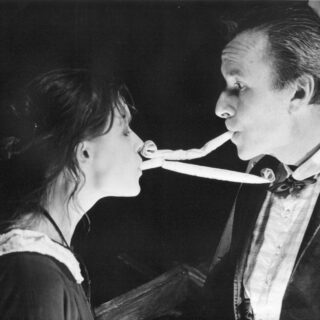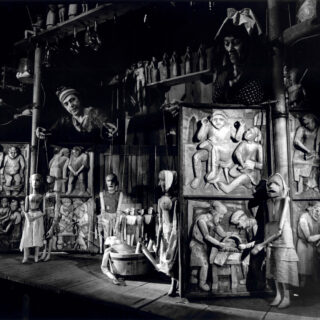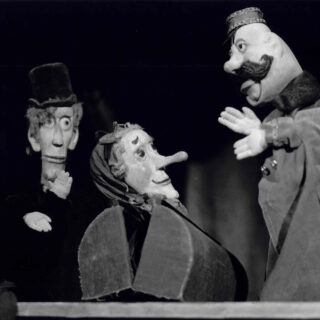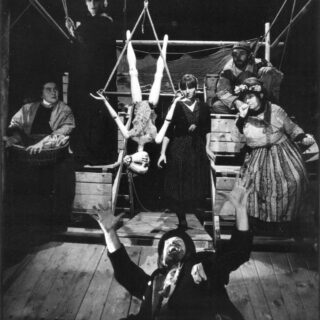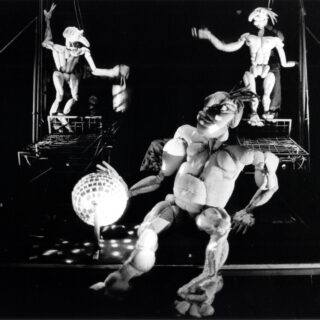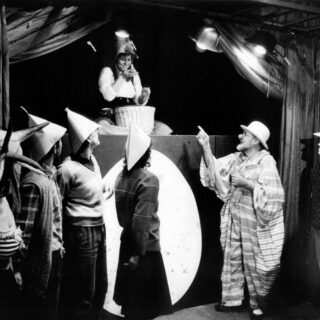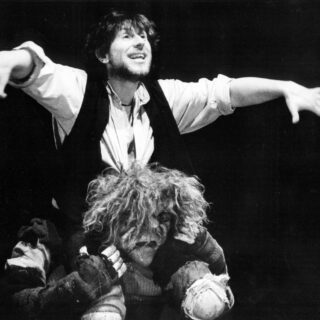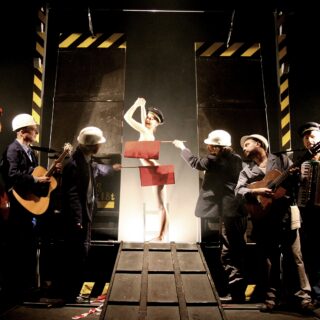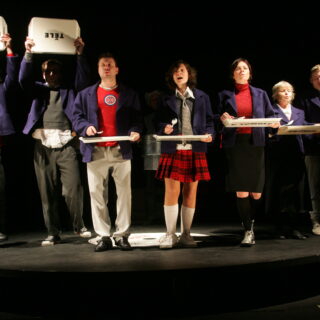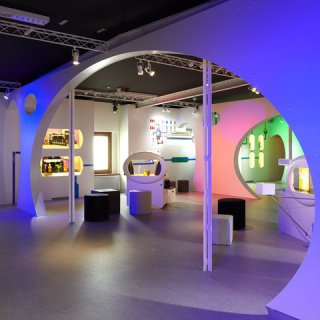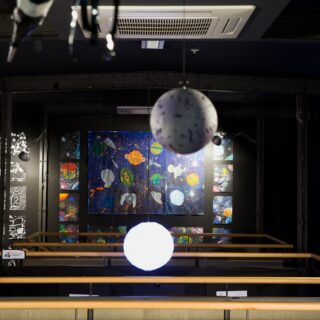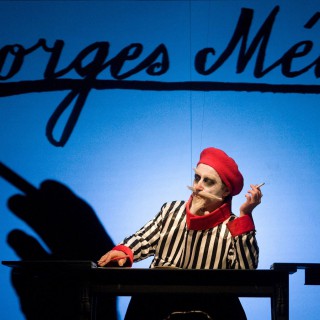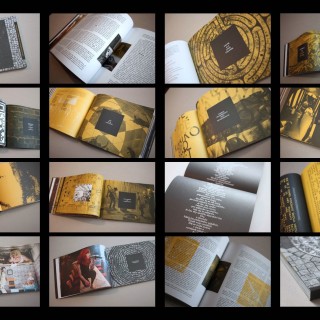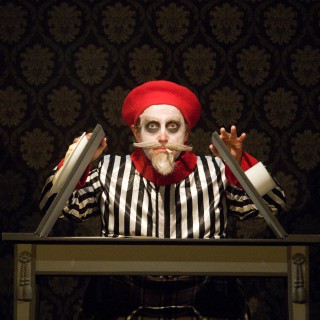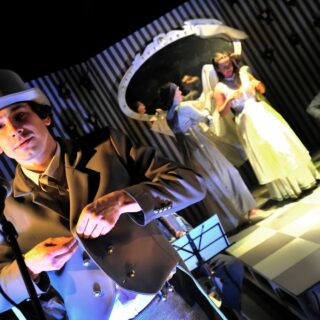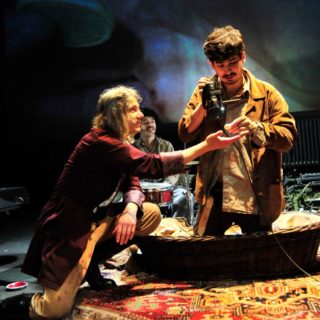DRAK Theatre History
Drak Theatre is located in the East Bohemian town of Hradec Králové. Its award-winning shows are aimed at both children and adults and known throughout the world for their originality and imaginative style. They are based on the traditions of (East) Bohemian puppetry as well as devised theater. Throughout its history, Drak has been a pioneer of new methods and creative approaches. Drak Theatre produces plays that appeal to the whole family, from toddlers to grandparents.
Over 60 years, productions of Drak, a proud heir of the strolling puppetry legacy, have been seen by spectators in more than 650 towns and cities located in 38 countries over five continents (Europe, Asia, Australia, North and South America). These countries’ population totals 1 571 275 000 inhabitants, which is 21% of the world’s population, speaking 34 different official languages. Their entire area consists of 59 425 774 km, hence approx. 12% of the Earth’s surface, resp. about 40% of the planet’s land. The total distance sum of the capitals from Hradec Králové is 119 155 km, which is about three times the equator’s length, or 200 000 times more than the distance from Drak theatre to their lodging in Tomkova street, or to the pub Na Hradě.
The history of the professional puppet theatre in Hradec Králové dates back to 1958, when the troupe was founded, originally under the name of Hradecké (later Východočeské) loutkové divadlo (East Bohemian puppet theatre); a name which was in 1968 complemented with an acronym DRAK (Divadlo Rozmanitosti, Atrakcí a Komedie či podle jiného výkladu divadlo Radosti, Atrakcí a Kouzel – Theatre of Diversity, Attractions and Comedy, or according to some, Theatre of Joy, Attractions and Magic). During the first years of its existence the troupe did not have their own venue, and performed e.g. in the premises of Hradec Králové Museum or on various tours. Its permanent stage opened in 1963 in the building of former student dormitory.
This foundational era is connected with its first managing director Vladimír Matoušek, who founded the ensemble and brought to Hradec Králové Jan Dvořák, a dramaturge and later Matoušek’s successor. Dvořák ran the theatre from 1965 to 1980 and became a prominent figure of Czech puppet theatre in general.
The first production Kouzelné pantoflíčky (Magical Slippers) premiered on 16. 2. 1959. Early seasons were influenced by limited possibilities of the ensemble as they had no permanent stage. Theatre thus focused on less demanding and easily transportable productions. However, this period marks the foundation of emerging ensemble. Many founding members became an inseparable part of Drak theatre’s life for decades and contributed to increasing development of the theatre.
Searching for a distinct style of Drak is connected with two directors. Jiří Středa enriched the repertoire with non-traditional puppet shows for adults, and brought the stage designer Pavel Kalfus, whose design is inseparably connected with this period. Miroslav Vildman expanded the ensemble by bringing his former classmate Jiří Vyšohlíd, who composed his first score for Žabák hrdina (The Frog Hero, 1968). Vildman’s innovative plays made the theatre respected and admired by the whole theatre community.
- Kouzelné pantoflíčky
- Žabák hrdina
- Nalaďte si vidličku
The first ground-breaking production in the history of Drak was Pohádka z kufru (Fairy Tale from a Suitcase, 1965) by Miroslav Vildman. The confrontation of modern clownery with traditional marionettes was an international sensation. Josef Krofta’s production Aby děti věděly (For Children to Know, 1972), in which puppets replaced objects of daily use, went further in exploring the theatricality and metaphorical use of art objects of and opened new perspectives for the puppet theatre.
Drak theatre had always been aware of its comedian roots, and within four years a triptych of productions based on folk puppetry themes was created. Johanes Doctor Faust (1971) by Matěj Kopecký was directly linked to their family tradition of strolling puppetry. The play Jak se Petruška ženil (How Petruška Was Getting Married, 1973) was based on the legacy of traditional glove puppet slapstick comedy. Finally, Eulenspiegel (Enšpígl, 1974) with original stage design by František Vítek recalled original German folk prankster.
- Pohádka z kufru
- Enšpígl
- Jak se Petruška ženil
The peak period of Drak is connected with the director Josef Krofta and his legendary creative team consisting of Petr Matásek (stage designer) and Jiří Vyšohlíd (actor and music composer). Their first production Popelka (Cinderella, 1975) won a prize at the World Festival of Puppet Theater in Moscow. Other more original and distinctive productions soon followed, whose stage design outdid the preceding shows and paved way for even more idiosyncratic production poetics of Drak those days. When the dramaturge Miloslav Klíma joined the ensemble, the theatre reached its peak and Drak became internationally renowned.
In 1977 and 1978, Drak created two plays which enabled the theatre to visit the American continent for the first time. The first production, Šípková Růženka (Sleeping Beauty, 1977), based on the classical ballet by Tchaikovsky was acted without words and took place in the backstage of the ballet – performed fragmentarily as a shadow play, with the puppets parodying the romantic tale backstage. A year later Unikum – Dnes naposled! (Unikum – Today for the Last Time!, 1978) was inspired by circus milieu which had always attracted Krofta. Zlatovláska (Goldilocks, 1981) highlighted one of the theatre’s characteristic features – collective, ensemble acting. In the production Píseň života (Song of Life, 1985) was emphasized the issue of manipulation by all possible means. Another production, Prodaná nevěsta (The Bartered Bride, 1986) was based on the original music by Jiří Vyšohlíd, who wrote and adjusted all the arias for choirs.
- Aby děti viděly
- Unikum. Dnes naposled!
- Píseň života
The creation of Mlýnek z Kalevaly (The Mill from Kalevala, 1987) was a complicated process. The first version was found poorly done by the theatre itself and was completely reworked. The second version then claimed international success. Královna Dagmar (Queen Dagmar, 1988) was created in collaboration with Odense Teater in Denmark. Petr Matásek created one of his most famous stage objects for this play – a kinetic sculpture with a triangular profile resembling a ship.
Over 40 years Josef Krofta created more than fifty productions in Drak. Popelka (Cinderella, 1975) is still reminded by the wooden panelling of the theatre’s main stage. Krofta became internationally renowned in the 1980s; he also began to work and teach abroad much more often, but still continued producing unique plays in Drak. With the extraordinary Pinokio (Pinocchio, 1992) Drak visited the USA again and received a number of awards along with many other plays. Two acclaimed productions created after 2000, Jak si hrají tatínkové (How Daddies Play, 2005) and Zlatovláska podle M.D.Rettigové,(Goldilocks by M. D. Rettigova, 2009) are still performed today.
- Mlýnek z Kalevaly
- Zpívej, klaune!
- Mystéria Buffa
Another director personality, Jan Borna made a mark on Drak during his relatively short activity there (1989–1992). His first production of Zpívej, klaune! (Sing, Clown!) won the main prize at Mateřinka festival. Another remarkable event was his double-production of Mistero Buffo (1990), originally by Dario Fo, which was a unique opportunity for the two then leading actors of Drak, Vladimír Marek and Václav Poul. Finally, Borna based his expressive and poetic production of Kráska a zvíře (Beauty and the Beast, 1990) on visual symbolism supported by Jiří Vyšohlíd’s distinct music.
Following Drak’s international success, other theatres and foreign art schools wanted to cooperate with the director Josef Krofta and the stage designer Petr Matásek. Krofta took advantage of social changes after the Velvet Revolution and in 1993 established the International Institute of Figurative Theatre to recognize the necessity of studying, researching, and seeking a new artistic face of theatre for children so that if can fulfil its modern mission. Currently, the institute is an educational and research theatre centre.
Drak has been cherishing international collaboration since the 1970s (Jánošík, 1975). Return of freedom after the Velvet Revolution enabled more intensive international cooperation and led to many projects. The first such play, Babylónská věž (The Tower of Babel, 1993), was co-produced with Institut de la Marionette in France and DAMU in Prague and premiered in Charleville-Mézières. Babylónská věž was followed by a number of other projects. This intensive period reached its climax in 2001 with Mor na ty vaše rody! (A Plague on Both Your Houses!), which was created in cooperation with Japan Foundation.
In 1995, Jakub Krofta became Drak’s permanent director, and later its artistic director. This period marked theatre’s new development. Krofta was soon followed by his classmate, the stage designer Marek Zákostelecký. In Drak, they began to develop new poetics based on their approach to theatre for children and youth. Their most distinctive shows became works for the youngest children, namely Jé! Kdo to je? (Wow! Who Is It?, 1998), Hopla! Kukla pukla! (Hop! Pupa Burst Open!, 2002), and O pejskovi a Kočičce (All About Doggie and Pussycat, 2007). Still, the nonverbal clownery Všechno lítá, co peří má (The Flying Babies, 2001), was an absolute triumph. Having received a number of awards, with almost 500 reprises performed for 15 years on 5 continents, the show is one of the most famous productions in the history of the ensemble. The cycle of productions aimed at adolescents, absolutely dramaturgically unique at that time, was titled Vyskočit z dětství (To Jump Out of Childhood) and its core consisted of the following triptych: Alenka zamilovaná (Alice in Love, 2004), Tajný deník Adriana Molea (The Secret Diary of Adrian Mole, 2006) and Carmen 20:07 (2007). However, besides the to two main dramaturgical lines of Krofta – Zákostelecký’s productions, clowneries for the youngest, and productions for adolescents, there is an outstanding staging of Těsnohlídek’s Liška Bystrouška (The Cunning Little Vixen, 2002), thematically multi-layered and minimalistically precise in staging, where original illuminated puppets dominated.
- Carmen 20:70
- Všechno lítá co peří má
- Tajný deník Adriana Molea
The 2010s has brought many changes: the legendary director Josef Krofta and the long-term managing director Jana Dražďáková bid farewell to Drak. Eliška Finková became the new managing director. She invited the dramaturge and the artistic director Dominika Špalková. Drak also relaunched collaboration with visiting directors. One of them, Jakub Vašíček, has become, after Jakub Krofta and Marek Zákostelecký, ensemble’s new core director as well as Drak’s artistic director. Since the season 2014/2015 he works in Drak together with the dramaturg Tomáš Jarkovský.
In 2010 theatre expands: a venue called Labyrint opens, featuring a new studio stage, interactive laboratory and exhibition spaces, which led to the reopening of the International Institute of Figurative Theatre, and to the development of educational, exhibition and residential programmes.
- Divadelní Laboratoř v Labyrintu Divadla Drak
- Krátkodobé výstavy
- Muzeum Labyrint
In 2013 the director Jiří Havelka and the stage designer Marek Zákostelecký premiered their Poslední trik Georgese Mélièse (George Méliès’ Last Trick) as homage to magic, film and imagination, inspired by the life of the cinematography pioneer. After many years of preparation Havelka and Zákostelecký finally decided to premiere at Drak, taking advantage of perfect acting skills of the ensemble as well as theatre’s unique technical facilities. They created a powerful production captivating by its theatrical illusion, compelling atmosphere, technical brilliance, ingenious story and perfect construction of gags. The show has been awarded many national and international awards (The Theatre Newspaper Award, Erik, etc.) and is invited to festivals worldwide.
- Poslední trik Georgese Méliese
- Labyrint světa
- Georges Méliese’s Last Trich
In the spring of 2015 both buildings of Drak theatre with is forecourt, where a white dome was built, were transformed into Comenius’ Labyrinth of the world. This was a result of a unique interactive project devised by Dominika Špalková, Ondrej Spišák and Tomáš Žižka, fusing installation art, exhibition and parlour game. The immersive project turned spectators into wanderers moving through an imaginary world, thus experiencing first-hand, like Comenius’ wanderer, various estate or the Castle of Fortune.
Jiří Vyšohlíd was awarded Thálie Award for lifelong achievement in puppet theatre in 2016. He has been working in Drak continuously since 1968. He joined as a member of the acting ensemble, which he remains to this day, but soon became theatre’s core composer and an accompanist. In 1992 he directed for the first time – a musical production for Drak, Nalaďte si vidličku (Tune the Fork), intended for the youngest children. Vyšohlíd occasionally returned to directing both as a guest director abroad, and in Drak where he directed five more productions. The glove-puppet Shakespearean slapstick play Hamlet (2004) became highly prominent, and the play Štěně nebo špenát? (Puppy or Spinach?, 2005) was a great success at festivals. His legendary Černošská pohádka (The African Tale, 1999) has been on the repertoire for an incredible twenty years.
The director Jakub Vašíček in creative tandem with the dramaturge Tomáš Jarkovský has created over 12 productions in Drak. Their first production was a musical performance about longing to fly to the sun called Ikaros (2013), followed by an adventure story of chasing one’s dreams called Amundsen kontra Scott (2014), a production based on classical fairy-tales for the youngest, A do třetice všeho.. (The Third Time…, 2015), or the story about a transformation of a cruel princess from the One Thousand and One Nights called Princezna Turandot (Princess Turandot, 2015). Two most distinct productions of the creative tandem are linked with the motif of white colour. They were both shortlisted for Theatre Newspaper Award; Bílý Tesák (White Fang, 2018) was awarded with Erik prize for the most inspiring puppet production of the season. The production O bílé lani (White Doe, 2016) is a fairy-tale parable tuned into dramatic concert. The show is built on Jana Skácel’s verse musicalized by Jiří Vyšohlíd, who received the prestigious Theatre Critique Award for his extraordinary score.
- O bílé lani
- Amundsen contra Scott
- Bílý tesák
Bílý tesák (White Fang, 2018), production based on the famous adventure novel by Jack London, combines puppetry principles with live cinema elements. The production is based on the tension between theatrical image or mise-en-scène, and cinematic image mediating subjective gaze of the main protagonist, projected onto the screen behind the stage. Camera thus becomes a puppet – animatable, relatable; its significance lies not in camera’s appearance, but its vision. Milan Hajn was awarded Thálie Award for his acting performance in this production in 2019.
To commemorate 30th anniversary of Velvet Revolution, a new production called Zeď, aneb jak jsem vyrůstal za železnou oponou (The Wall: Growing Up behind the Iron Curtain, 2019) was created. It is a devised project of two directors, Miřenka Čechová and Dominika Špalková. The production about the hope in which we cannot stop trusting is based on the book of the same name by Petr Sís,
After a whole decade in the management of the theatre Eliška Finková decided to retire at the end of 2019 and a the dramaturg Tomáš Jarkovský becomes the new managing director of the theatre in January 2020.
